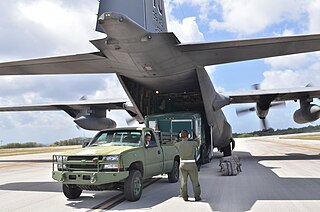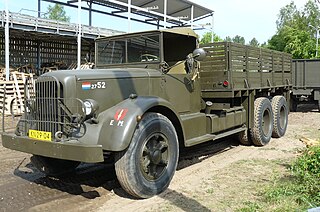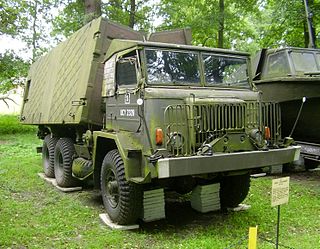
The Studebaker US6 (G630) was a series of 2+1⁄2-ton 6×6 and 5-ton 6×4 trucks manufactured by the Studebaker Corporation and REO Motor Car Company during World War II. The basic cargo version was designed to transport a 2+1⁄2-short-ton cargo load over any type of terrain in any weather. Most of these were exported to the Soviet Union under Lend-Lease by the US during World War II, since the competing GMC 6×6 CCKW design proved to be more suitable for Western Front conditions.

A gun truck is an armored vehicle with one or more crew-served weapons, typically based on a military truck. Gun trucks often have improvised vehicle armor, such as scrap metal, concrete, gravel, or sandbags, which is added to a heavy truck.

The Austin armoured car was a British armoured car produced during the First World War. The vehicle is best known for its employment by the Imperial Russian Army in the First World War and by different forces in the Russian Civil War.

The M35 2½-ton cargo truck is a long-lived 2½-ton 6×6 cargo truck initially used by the United States Army and subsequently utilized by many nations around the world. Over time it evolved into a family of specialized vehicles. It inherited the nickname "Deuce and a Half" from an older 2½-ton truck, the World War II GMC CCKW.

The Commercial Utility Cargo Vehicle, later the Light Service Support Vehicle (LSSV), is a vehicle program instituted to provide the United States military with light utility vehicles based on a civilian truck chassis.

Raupenschlepper Ost was a fully tracked, lightweight vehicle used by the Wehrmacht in World War II. It was conceived in response to the poor performance of wheeled and half-tracked vehicles in the mud and snow during the Wehrmacht's first autumn and winter on the Soviet Front.

The D-442 FUG and D-944 PSZH are the result of Hungarian domestic development of relatively cheap amphibious armoured scout car and armored personnel carrier series. The FUG and PSZH were exported with limited success, thus it is also known under its Czechoslovak designation OT-65.

The Star 266 is a Polish 6x6 truck designed for transport of cargo and personnel. Created by Starachowice-based FSC Star, it was the basic transport truck used by the Polish Army. It was also available to civilian market. A successor to a highly successful Star 660 series of trucks, the Star 266 shared many components with earlier models, including Star 200 and Star 244 multi-purpose medium-capacity trucks.
The MAP75 armoured personnel carrier is a Rhodesian 4x4 heavy troop-carrying vehicle (TCV) first introduced in 1978 based on a Mercedes-Benz truck chassis. It remains in use with the Zimbabwe National Army.

The VPK-3927 Volk is a Russian 4×4 multipurpose military armoured vehicle, manufactured by Military Industrial Company. The Volk family was developed by modifying a previous model by Military Industrial Company, the Tigr.

The MAN Category 1 is a family of high-mobility off-road trucks developed by MAN SE for the German army. Production continued through an evolution of the design with the final iteration (SX) in production until early 2019.

The HX family are a range of purpose-designed tactical military trucks manufactured by Rheinmetall MAN Military Vehicles (RMMV). The HX range was disclosed in 2003, and the first order was placed in 2004. The HX range replaced the earlier FX and LX ranges in production.

The Logistic Vehicle System Replacement (LVSR) is a family of heavy-duty military logistics vehicles of the United States Marine Corps (USMC) based on a common 5-axle ten-wheel drive (10x10) chassis. The vehicles vary in individual configuration by mission requirements, with three variants in service: a cargo, a wrecker and a tractor truck. The LVSR was designed and is manufactured by Oshkosh Defense.

Rheinmetall MAN Military Vehicles (RMMV) TG MIL range of trucks is based on MAN TG range commercial chassis that are militarised to suit individual customer requirements. The TG MIL was introduced from 2010 when RMMV was established in January of that year. RMMV was initially the merger of Rheinmetall's wheeled military vehicle activities with those of the military truck activities of the now MAN Truck & Bus AG, but from 2019 the joint venture focuses only on logistic vehicles. Prior to 2010 militarised TGM and TGA range trucks were products of the now MAN Truck & Bus AG.

The Mack NR was a heavy 6x4 cargo truck designed and produced in the 1940s by the American manufacturer Mack Trucks. It was used mainly by the British Army to transport cargo and materiel over long distances during World War II. The official U.S. Army designation was: Truck, 10 ton, 6x4, Cargo. Its G-number was (G-528).

The SAMIL 20 is a 2-ton cargo vehicle produced in South Africa in the mid-1980s and was used as the primary light cargo carrier of the South African National Defence Force. The vehicle design is based on the German Mercedes Unimog chassis and Mark I of this vehicle was based on the Magirus Deutz 130M7FAL 4x4 truck. In Mark II, the engine was replaced with an upgraded South African built water cooled diesel engine. The vehicle is still in use with the SANDF.

Jelcz 800 – A series of trucks intended for military use with increased or high off-road mobility, built in a four-axle configuration, manufactured by Jelcz, equipped with 2-, 4- and 6-person cabins adapted for the installation of additional armor or integrally armored in a standard or reduced-height version.

The Star 660 is a Polish 6x6 truck designed for transport of cargo and personnel. Created by Starachowice-based FSC Star, it was the basic transport truck used by the Polish People's Army. It was replaced by the Star 266.

The Star 244 is a Polish 2 axle straight truck produced by FSC Star in Starachowice from 1975 to 2000.

The Star 1142 is a Polish truck produced in 1986-2000 by FSC Star in Starachowice, Poland. It is the successor to the Star 200.




















